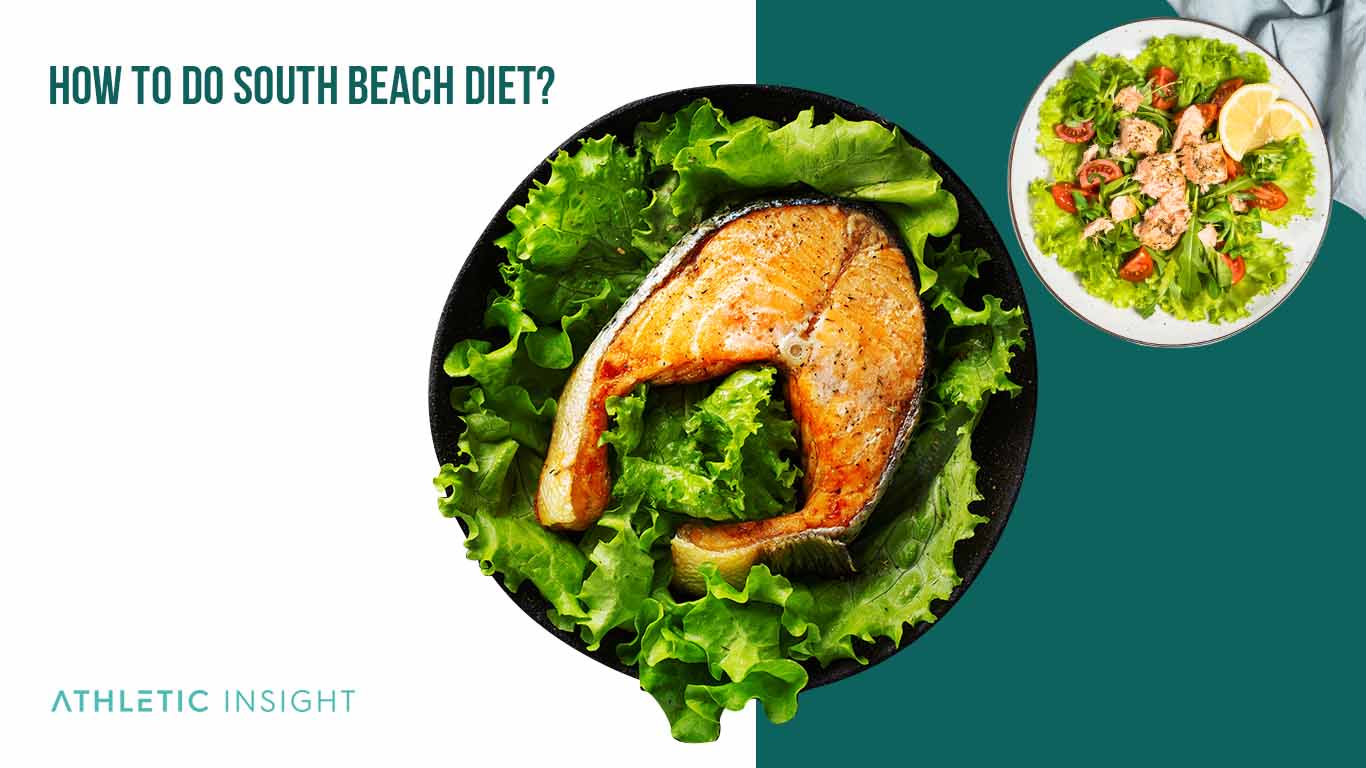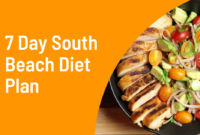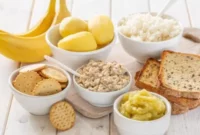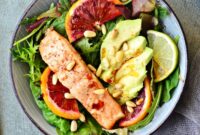South Beach Diet Explained: Uncover the secrets behind this popular weight-loss plan. We’ll delve into its three phases, exploring the specific food restrictions and allowances at each stage. Discover the science behind the diet’s approach, understanding its benefits and potential drawbacks, all while considering its unique position among other popular weight-loss strategies. This comprehensive guide provides a clear and concise understanding of the South Beach Diet, empowering you to make informed decisions about your health and well-being.
From the initial restrictive phase focused on eliminating unhealthy fats and sugars to the gradual reintroduction of carbohydrates, we’ll examine the practical application of the diet. We’ll also analyze its effectiveness compared to other popular diets, highlighting its strengths and weaknesses. By the end, you’ll have a firm grasp of whether the South Beach Diet is the right choice for you.
Introduction to the South Beach Diet
The South Beach Diet, created by cardiologist Arthur Agatston, is a low-carbohydrate diet that emphasizes the types of carbohydrates consumed rather than simply restricting total carbohydrate intake. Unlike some other low-carb diets that severely limit all carbohydrates, the South Beach Diet prioritizes “good” carbohydrates while limiting “bad” carbohydrates, aiming for gradual weight loss and improved heart health. The core principle revolves around managing insulin levels to curb cravings and promote sustained weight management.
The diet’s structure is based on three phases, each with progressively less restrictive guidelines. This phased approach allows for gradual lifestyle changes and helps prevent the common pitfalls associated with rapid weight loss diets. The rationale behind this structured approach is to promote healthy eating habits that can be maintained long-term, thereby preventing weight regain. The claimed benefits include weight loss, improved blood sugar control, reduced cholesterol levels, and increased energy.
Phases of the South Beach Diet
The South Beach Diet is divided into three phases: Phase 1, Phase 2, and Phase 3. Each phase has specific guidelines regarding food choices and portion sizes. Understanding these phases is crucial for successfully following the diet.
- Phase 1: This is the initial, most restrictive phase, lasting two weeks. It focuses on eliminating “bad” carbohydrates such as refined sugars, processed foods, and white bread. Good carbohydrates, like whole grains and fruits, are also limited during this phase. The goal is to quickly reduce blood sugar levels and curb cravings. Healthy fats and lean proteins are encouraged.
- Phase 2: Once the initial weight loss is achieved (typically in the first two weeks), Phase 2 begins. This phase gradually reintroduces some healthy carbohydrates, such as whole grains and certain fruits, while continuing to limit less healthy carbohydrate choices. The focus shifts towards maintaining weight loss and establishing sustainable eating habits. This phase can last until the desired weight is reached.
- Phase 3: This is the maintenance phase, designed to help individuals maintain their weight loss long-term. It involves further broadening the range of healthy foods, including a wider variety of carbohydrates, but still emphasizes healthy choices and portion control. The key is to maintain the healthy habits learned during the previous phases.
Rationale and Claimed Benefits of the South Beach Diet
The South Beach Diet’s rationale lies in its emphasis on controlling blood sugar levels through the careful selection of carbohydrates. By limiting rapidly digested carbohydrates, the diet aims to prevent blood sugar spikes and subsequent insulin surges. These spikes often lead to increased hunger and fat storage. The diet’s focus on healthy fats and lean proteins helps to keep individuals feeling full and satisfied, promoting weight loss and reducing cravings.
The claimed benefits, supported by anecdotal evidence and some studies, include weight loss, improved cholesterol levels, reduced blood pressure, and better blood sugar control. However, it’s important to note that individual results may vary, and long-term studies are still needed to fully assess the diet’s efficacy and potential long-term effects. The diet’s success often hinges on adherence to the guidelines and making sustainable lifestyle changes.
Phase 2
Phase 2 of the South Beach Diet marks a significant transition. After the initial two-week period of strict carbohydrate restriction, this phase focuses on gradually reintroducing healthy carbohydrates back into your diet while maintaining the emphasis on lean proteins, healthy fats, and plenty of vegetables. This gradual approach helps prevent sudden weight gain and allows your body to adjust to a more balanced nutritional intake. The goal is to find a sustainable eating pattern that supports long-term weight management and overall health.
This phase extends for the duration needed to achieve your weight goals, typically lasting several weeks or even months, depending on individual progress. It’s crucial to listen to your body and adjust your carbohydrate intake accordingly.
Carbohydrate Reintroduction in Phase 2
In Phase 2, you’ll begin adding back select carbohydrates, focusing on those with a lower glycemic index (GI). These carbohydrates are digested and absorbed more slowly, leading to a more gradual rise in blood sugar levels, minimizing insulin spikes, and promoting sustained energy. The amount of carbohydrates you consume will depend on your individual needs and response to the diet. Start slowly, monitoring your weight and energy levels. If you experience weight gain or other negative effects, reduce your carbohydrate intake. If you maintain your weight or continue to lose weight, you can gradually increase the amount of carbohydrates.
Suitable Carbohydrate Sources
Several carbohydrate sources are permitted during Phase 2. These include whole grains like whole-wheat bread and pasta (in moderation), brown rice, quinoa, and oats. Fruits are also included, but it’s best to choose lower-GI fruits like berries, apples, and pears over higher-GI fruits like bananas and mangoes. Legumes, such as lentils and chickpeas, are excellent sources of fiber and protein, contributing to satiety and overall health.
Phase 2 Recipes
The following recipes exemplify the balance of lean protein, healthy fats, and carefully chosen carbohydrates suitable for Phase 2. Remember to adjust portion sizes to meet your individual caloric needs.
- Quinoa Salad with Grilled Chicken and Roasted Vegetables: This recipe combines protein-rich grilled chicken with fiber-rich quinoa and a variety of roasted vegetables like broccoli, bell peppers, and zucchini. A light vinaigrette dressing adds flavor without excess calories.
- Lentil Soup with Whole-Wheat Bread: A hearty and nutritious soup packed with protein from lentils and vegetables. A slice of whole-wheat bread adds a satisfying carbohydrate element.
- Salmon with Roasted Asparagus and Brown Rice: This dish features heart-healthy salmon, fiber-rich asparagus, and a moderate portion of brown rice. The combination provides a well-rounded meal with a good balance of macronutrients.
- Turkey Meatloaf with Sweet Potato Mash: This recipe offers a lean protein source in the turkey meatloaf, paired with a side of sweet potato mash, providing a healthier alternative to traditional mashed potatoes.
- Chicken Stir-fry with Brown Rice Noodles: A flavorful and versatile stir-fry using lean chicken breast, plenty of vegetables, and a light sauce. Brown rice noodles provide a moderate carbohydrate source.
Food Choices and Restrictions
The South Beach Diet, while flexible, does necessitate careful food selection to maximize its effectiveness. Understanding which foods to limit or avoid is crucial for achieving the diet’s goals of weight loss and improved metabolic health. This section details the foods to restrict and highlights the healthy fats encouraged within the South Beach Diet framework.
Foods to Avoid on the South Beach Diet
The South Beach Diet emphasizes minimizing foods high in refined carbohydrates and unhealthy fats. These foods often lead to rapid spikes in blood sugar, contributing to weight gain and other health problems. Avoiding these foods is key to the diet’s success.
- Sugary drinks: Sodas, sweetened juices, and other sugary beverages are strictly limited due to their high sugar content and lack of nutritional value.
- Processed foods: Most processed foods are high in unhealthy fats, added sugars, and refined carbohydrates. This includes many packaged snacks, frozen meals, and fast food.
- White bread and pastries: These are refined carbohydrates that are quickly digested, leading to blood sugar spikes.
- Sugary cereals: Many breakfast cereals are high in sugar and low in fiber.
- Most fruits (Phase 1): While fruits are generally healthy, high-sugar fruits are restricted in Phase 1 due to their rapid sugar absorption.
- Trans fats: These are artificial fats found in many processed foods and should be avoided completely.
- High-fructose corn syrup: A highly processed sweetener that should be avoided.
Healthy Fats Encouraged by the South Beach Diet
The South Beach Diet doesn’t demonize fats; instead, it distinguishes between healthy and unhealthy fats. The diet encourages the consumption of healthy fats, which are crucial for satiety, hormone production, and overall health.
- Monounsaturated fats: Found in olive oil, avocados, nuts (like almonds and cashews), and seeds. These fats help lower LDL (“bad”) cholesterol.
- Polyunsaturated fats: Found in fatty fish (like salmon and tuna), flaxseeds, and walnuts. These fats are rich in omega-3 fatty acids, beneficial for heart health.
- Saturated fats (in moderation): Found in sources like coconut oil, red meat (lean cuts), and dairy products (full-fat yogurt). While saturated fats should be consumed in moderation, they are not entirely eliminated from the diet.
Comparison of South Beach Diet’s Carbohydrate Approach with Other Diets
The South Beach Diet’s approach to carbohydrates differs significantly from other popular diets. Unlike some low-carb diets that severely restrict all carbohydrates, the South Beach Diet focuses on eliminating refined carbohydrates while allowing for moderate consumption of complex carbohydrates, such as whole grains and certain fruits, in later phases.
| Diet | Carbohydrate Approach |
|---|---|
| South Beach Diet | Restricts refined carbohydrates; allows complex carbohydrates in later phases. |
| Ketogenic Diet | Severely restricts carbohydrates, promoting ketosis. |
| Atkins Diet | Very low carbohydrate intake initially, gradually increasing carbohydrate intake. |
| Mediterranean Diet | Emphasizes whole grains, fruits, and vegetables; moderate carbohydrate intake. |
Potential Benefits and Risks
The South Beach Diet, like any dietary approach, presents potential benefits and drawbacks. Understanding these aspects is crucial for making an informed decision about whether it aligns with your individual health goals and circumstances. While it can lead to weight loss and improvements in certain health markers, it’s essential to be aware of potential downsides and to consult a healthcare professional before embarking on this or any other restrictive diet.
Potential benefits often cited for the South Beach Diet include weight loss, improved blood sugar control, and reduced cholesterol levels. These are frequently observed in individuals following the initial phases of the diet, which emphasizes low-glycemic index foods and limits refined carbohydrates and sugars. However, the long-term sustainability and maintenance of these benefits require careful consideration.
Health Benefits of the South Beach Diet
The South Beach Diet’s emphasis on whole, unprocessed foods, lean proteins, and healthy fats can contribute to several positive health outcomes. Studies have shown that diets rich in these components are associated with lower risks of heart disease, type 2 diabetes, and some types of cancer. For example, a diet high in fiber, as promoted in the South Beach Diet’s later phases, can improve gut health and contribute to feelings of satiety, aiding in weight management. Furthermore, the diet’s focus on limiting processed foods and added sugars can lead to improvements in blood sugar control and reduced inflammation, which are beneficial for overall health. While specific studies directly examining the South Beach Diet’s long-term effects are limited, the principles underpinning the diet align with established dietary guidelines promoting cardiovascular health and weight management. These principles are supported by extensive research from organizations like the American Heart Association and the National Institutes of Health.
Potential Drawbacks and Side Effects
While the South Beach Diet can yield positive results, it’s important to acknowledge potential drawbacks. Some individuals may experience initial side effects like headaches, fatigue, or constipation, particularly during the initial restrictive phases. These are often temporary and related to the body’s adjustment to the dietary changes. The restrictive nature of the diet’s early phases can also make it challenging to maintain long-term, leading to potential weight regain after cessation. Furthermore, the diet’s exclusion of certain food groups may lead to nutrient deficiencies if not carefully planned. For instance, restricting entire food groups could lead to a lack of essential vitamins and minerals. Finally, the social aspects of eating can be impacted; the diet’s restrictions may make it difficult to participate in social events centered around food.
Importance of Consulting a Healthcare Professional
Before starting any new diet, including the South Beach Diet, it’s crucial to consult a healthcare professional, such as a doctor or registered dietitian. They can assess your individual health status, identify any potential risks or contraindications, and help you create a safe and effective plan. They can also monitor your progress and address any concerns that may arise during the process. This personalized approach ensures that the diet aligns with your specific needs and health goals, minimizing the risk of potential complications. Ignoring this crucial step can lead to unintended consequences and potentially compromise your health.
Recipes and Meal Planning
The South Beach Diet emphasizes balanced meals rich in lean protein, healthy fats, and complex carbohydrates. Careful meal planning is crucial for successful weight management and adherence to the diet’s phases. A well-structured meal plan ensures you consume adequate nutrients while avoiding processed foods and excessive sugars. The following provides a sample meal plan and recipes to guide your culinary journey.
Sample 7-Day Meal Plan
A sample 7-day meal plan adhering to South Beach Diet principles is presented below. Remember to adjust portion sizes based on your individual caloric needs and activity level. This plan is a suggestion and can be modified to suit personal preferences, using the provided recipes as inspiration.
| Day | Breakfast | Lunch | Dinner |
|---|---|---|---|
| Monday | Greek yogurt with berries and a sprinkle of almonds | Large salad with grilled chicken breast and olive oil dressing | Baked salmon with asparagus and quinoa |
| Tuesday | Scrambled eggs with spinach and whole-wheat toast | Turkey breast and avocado sandwich on whole-wheat bread | Chicken stir-fry with brown rice |
| Wednesday | Oatmeal with berries and a small amount of nuts | Leftover chicken stir-fry | Lean ground beef with steamed broccoli and a sweet potato |
| Thursday | Greek yogurt with berries and a sprinkle of almonds | Tuna salad (made with light mayo) on whole-wheat crackers | Baked cod with roasted vegetables |
| Friday | Scrambled eggs with mushrooms and whole-wheat toast | Large salad with grilled shrimp and a light vinaigrette | Grilled chicken breast with a side salad |
| Saturday | Oatmeal with fruit and a small amount of nuts | Leftover grilled chicken breast with a side salad | Steak (lean cut) with steamed green beans |
| Sunday | Omelette with vegetables | Turkey and avocado wrap | Baked chicken breast with roasted sweet potatoes and Brussels sprouts |
South Beach Diet Recipes
Three unique recipes suitable for different phases of the South Beach Diet are provided below. Nutritional information is approximate and may vary depending on specific ingredients and portion sizes.
Phase 1: Shrimp and Avocado Salad
Ingredients: 1 cup cooked shrimp, ½ avocado, ¼ cup chopped red onion, 2 tablespoons lime juice, 1 tablespoon olive oil, salt and pepper to taste.
Instructions: Combine all ingredients in a bowl and mix gently. Serve immediately.
Nutritional Information (per serving): Approximately 250 calories, 20g protein, 15g fat, 5g carbohydrates.
Phase 2: Chicken and Vegetable Stir-fry
Ingredients: 1 lb boneless, skinless chicken breast (cut into strips), 1 cup broccoli florets, ½ cup sliced bell peppers, ½ cup sliced carrots, 2 tablespoons soy sauce (low sodium), 1 tablespoon olive oil, 1 clove garlic (minced), ginger (optional).
Instructions: Stir-fry chicken in olive oil until cooked through. Add vegetables and garlic/ginger, stir-fry until tender-crisp. Add soy sauce and cook for another minute.
Nutritional Information (per serving): Approximately 350 calories, 35g protein, 10g fat, 20g carbohydrates.
Phase 3: Salmon with Roasted Asparagus and Quinoa
Ingredients: 4 oz salmon fillet, 1 bunch asparagus, ½ cup quinoa, 1 tablespoon olive oil, salt, pepper, lemon juice.
Instructions: Preheat oven to 400°F (200°C). Toss asparagus with olive oil, salt, and pepper. Roast for 15-20 minutes. Cook quinoa according to package directions. Season salmon with salt, pepper, and lemon juice. Bake or pan-fry until cooked through.
Nutritional Information (per serving): Approximately 400 calories, 30g protein, 20g fat, 30g carbohydrates.
Sample South Beach Diet Meal Illustration
The image depicts a vibrant and healthy South Beach Diet meal. A grilled salmon fillet, glistening with a light sheen of olive oil, rests on a bed of tender, bright green asparagus spears. Beside it, a fluffy mound of cooked quinoa adds a creamy texture and complex carbohydrate source. The overall presentation is simple yet elegant, emphasizing the natural colors and textures of fresh, wholesome ingredients. The salmon’s pink hue contrasts beautifully with the asparagus’s green and the quinoa’s pale yellow, creating a visually appealing and nutritious meal. The absence of heavy sauces or dressings highlights the inherent flavors of the ingredients.
Comparison with Other Diets
The South Beach Diet, while sharing some similarities with other popular weight-loss plans like the Atkins and Mediterranean diets, possesses unique characteristics that distinguish it. Understanding these similarities and differences helps individuals choose the approach best suited to their needs and preferences. This comparison focuses on macronutrient intake and overall dietary philosophy.
Macronutrient Comparisons: South Beach, Atkins, and Mediterranean Diets
The three diets differ significantly in their approach to macronutrients. The Atkins diet emphasizes a very low carbohydrate intake, prioritizing protein and fat. This approach aims to induce ketosis, a metabolic state where the body burns fat for energy. In contrast, the Mediterranean diet emphasizes fruits, vegetables, whole grains, and healthy fats, with moderate protein intake. It’s less restrictive on carbohydrate intake compared to Atkins, focusing on nutrient-dense foods. The South Beach Diet occupies a middle ground. It restricts certain carbohydrates, particularly refined sugars and processed grains, in its initial phase, but allows for a more gradual reintroduction of healthy carbohydrates later. The emphasis remains on lean protein and healthy fats. The South Beach Diet’s phased approach allows for more flexibility and potentially greater long-term adherence compared to the more restrictive Atkins diet.
Dietary Philosophies and Unique Aspects of the South Beach Diet
The Atkins diet’s primary focus is rapid weight loss through significant carbohydrate restriction, potentially leading to initial rapid results but potentially also posing challenges for long-term adherence. The Mediterranean diet, on the other hand, emphasizes a holistic, lifestyle-based approach to healthy eating, promoting overall well-being rather than solely focusing on weight loss. The South Beach Diet distinguishes itself by combining elements of both. It prioritizes healthy weight loss without overly restrictive carbohydrate elimination, incorporating a gradual reintroduction of healthy carbohydrates, thus potentially mitigating the negative side effects associated with extremely low-carbohydrate diets. This phased approach addresses the issue of nutrient deficiencies and promotes sustainable lifestyle changes. Furthermore, the South Beach Diet provides detailed guidance on food choices and meal planning, making it more structured than the relatively less prescriptive Mediterranean diet. The emphasis on blood sugar control and the avoidance of processed foods distinguishes the South Beach Diet, making it a potentially suitable option for individuals with insulin resistance or those looking for a more balanced and sustainable weight loss approach compared to the more extreme restriction of the Atkins diet.
Last Point
The South Beach Diet, with its phased approach and focus on healthy fats and controlled carbohydrate intake, offers a structured path to weight loss. While individual results may vary, understanding the principles behind each phase – from the initial restrictions to the long-term maintenance – is key to success. Remember to consult a healthcare professional before embarking on any new diet plan. Ultimately, the South Beach Diet’s effectiveness hinges on your commitment to its guidelines and your overall health goals. By making informed choices and adopting a sustainable lifestyle, you can achieve lasting results.




